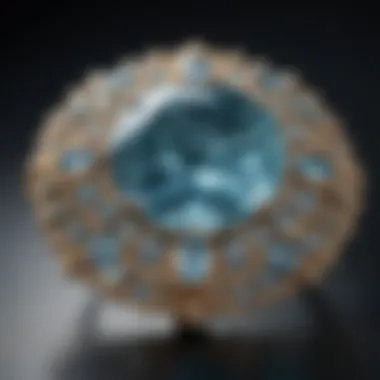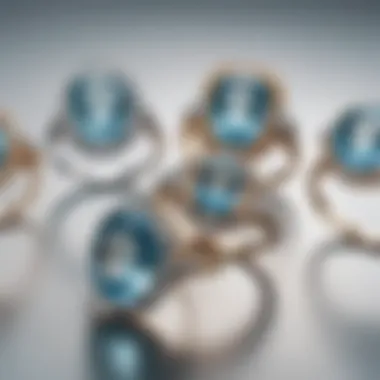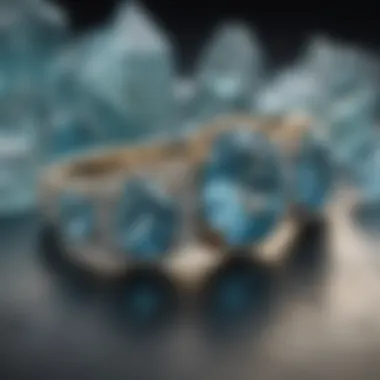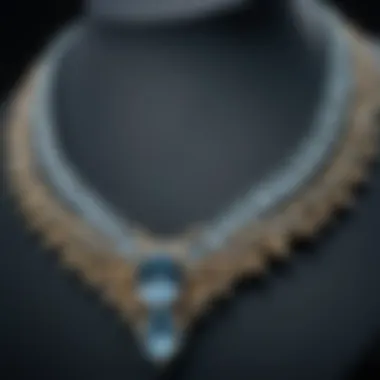Exploring the Allure of Antique Aquamarine Jewellery


Intro
Antique aquamarine jewellery embodies both beauty and cultural significance. This article guides the reader through its fascinating history and craftsmanship. By focusing on aquamarine, a captivating gemstone, we reveal its unique properties and artistic applications. Knowledge about identifying and taking care of such heirlooms is essential for collectors and enthusiasts. Understanding provenance helps to appreciate these artisanal pieces even more.
Overview of Gemstones and Minerals
Aquamarine is a member of the beryl family, comprising diverse gemstones with captivating hue and clarity. Each gemstone carries its story, shaped by geological factors and human craftsmanship.
History of Gemstone and Mineral Use
Historically, gemstones have been valued for their rarity, beauty, and believed metaphysical properties. Civilizations such as the Egyptians and Romans incorporated gemstones into their ornaments not simply for adornment but also for spiritual significance. Aquamarine was particularly cherished for its connection with the sea, believed to offer protection to sailors.
Significance in Culture and Society
Aquamarine's serene blue tone has made it an emblem of tranquility in various cultures. In Ancient Rome, it was worn by brides, while in Medieval Europe it symbolized empowerment. Today, it remains a staple in antique jewellery and continues to hold cultural relevance among gemstone enthusiasts.
Gemstone Formation and Properties
Understanding how gemstones like aquamarine form helps uncover their unique allure.
Formation Process of Gemstones
The formation of gemstones involves millions of years of geological changes. Aquamarine forms within pegmatite veins, where mineral-rich fluids cool slowly, allowing the growth of large, beautiful crystals. This process results in impressive clarity and color.
Properties that Define Gemstones
Several properties characterize gemstones, including hardness, luster, and refractive index. Aquamarine is known for its remarkable hardness, rating at 7.5 to 8 on the Mohs scale, making it ideal for jewellery. Its unique transparency enables light to enter the stone, producing brilliant reflections.
Classification based on Color, Hardness, and Luster
Gemstones can be classified using various criteria. Aquamarine typically exhibits a range of blues, often with slight greenish undertones. Understanding the variation in color can aid in evaluations and determine the authenticity of pieces.
Types of Gemstones
Gemstones fall into the categories of precious and semi-precious. This classification offers insight into their value and rarity.
Precious vs.
Semi-Precious Gemstones
Precious gemstones include diamonds, sapphires, rubies, and emeralds, while semi-precious ones comprise amethyst, garnet, and aquamarine. The distinction is often based on rarity and market demand, influencing both price and desirability in antique jewellery.
Common Gemstone Varieties
- Diamonds
- Sapphires
- Emeralds
- Amethysts
Exotic and Rare Gemstones
Emerging interest in exotic stones alters collector trends. Aquamarine holds historical provenance while still being accessible. Some rarities increase appreciation for unique pieces beyond mainstream selections.
Identifying and Evaluating Gemstones
Assessment is vital for collectors seeking authentic antique jewellery. Each piece carries distinctive markers of authenticity.
Factors Affecting Gemstone Value
Several factors contribute to gemstone valuation:
- Size: Larger stones tend to be more valuable.
- Color: Vivid, saturated colors attract greater attention.
- Clarity: Fewer inclusions indicate a higher quality.
Techniques for Gemstone Identification
Experts often employ various tools, such as microscopes and refractometers, to verify authenticity and quality. Knowledge of gemstone characteristics also aids collectors.
Assessing Gemstone Quality


Quality assessment assists buyers in choosing antique aquamarine pieces wisely. Understanding clarity grades and gemstone cuts enhances this evaluation process.
Caring for Gemstones
Proper care transcends mere maintenance. It speaks directly to the preservation of history.
Cleaning and Storing Gemstones Properly
Gentle cleaning is essential. Use mild soap and water. Store aquamarine away from extreme temperatures or exposure that could lead to scratching or altered colors.
Avoiding Common Mistakes in Gemstone Care
Avoid submerging antique pieces in harsh chemicals. Regularly inspect settings for scuffs and wear, ensuring longevity in look and structural integrity.
Preservation Tips for Specific Gem Types
For aquamarine specifically, maintain dryness in storage to prevent moisture-related damages. Regular gentle cleaning also aids in preserving theatrical brilliance.
Preamble to Antique Aquamarine Jewellery
Antique aquamarine jewellery holds a unique place within the realm of gemstones, known for both its astonishing aesthetic properties and its rich historical context. This section explores various aspects that define antique aquamarine pieces and delves into the journey of the aquamarine gemstone through time. By acknowledging the characteristics that make aquamarine a prized stone, readers can appreciate its genuine essence and what makes it widely sought after.
Definition and Characteristics of Aquamarine
Aquamarine is a translucent variety of the mineral beryl, defined by its striking blue to blue-green colors. The name itself draws its roots its Latin-Latin, where aqua means water and marina refers to the sea. This connection reflects the serene hues reminiscent of ocean waters. Typically, the best samples show clarity and a vivid color that effortlessly catches the eye. The preferred color for high-quality aquamarine is a deep, brilliant blue, akin to tropical seas. Moreover, aquamarine’s quality is determined by several elements, including:
- Color: Ranging from pale blue, reaching to deeper shades like aqua. The most coveted ranges feature rich blue tones without significant green undertones.
- Clarity: Excellent examples showcase minimal inclusions. Clarity is essential, as the presence of visible flaws can degrade the stone’s value.
- Cut: The brilliance of a well-cut aquamarine maximizes light refraction. Standard cuts include round, oval, and emerald-shaped configurations.
Recognizing these characteristics allows enthusiasts to identify exquisite examples of aquamarine in antique pieces.
Historical Context of Aquamarine
The historical backdrop of aquamarine dates back to ancient civilizations. Egyptians and Romans treasured the stone, often associating it with fertility and preservation. In their beliefs, aquamarine was akin to a talisman that protected sailors at sea, amplifying its admiration on maritime voyages. Furthermore, during various periods, the gemstone represented cheer and love.
As jewelry styles evolved over the centuries, so did the application of aquamarine. For instance, during the 19th century, it saw a resurgence in popularity, particularly during the Victorian era, where it embodied elegance and romance. The gemstone's soft blue colors adorned various pieces, including pendants, earrings, and tiaras.
The deeper understanding of wipes out unnecessary romanticism. Aquamarine is favored not just because of aesthetics, but also its rich inheritance made everlasting.
In sum, antique aquamarine jewelry serves as more than decorative collectibles. Each piece invites one to reflect upon its former life and the many historical narratives intertwined within. Being well-acquainted with the definitions and historical significance lays a solid foundation for understanding the broader context of antique aquamarine in jewellery collections.
The Allure of Antique Jewellery
The world of antique jewellery attracts many, offering a unique perspective on artistic expression and history. The allure of antique aquamarine jewellery goes beyond its shimmering beauty; it includes profound cultural stories, standing witness to eras long past. An appreciation of antique pieces means understanding not just the visible splendour of the gem but the significant history and craftsmanship behind each item. This appreciation holds value for enthusiasts, collectors, and anyone who recognises the depth and narratives that antique jewellery can manifest.
Cultural Significance of Antique Jewellery
Antique jewellery often carries in-depth cultural associations, symbolizing ideas of love, fidelity, and heritage. Different regions employed various gemological traditions, giving rise to distinctive styles that reflect societal values and historical contexts. For instance, aquamarine pieces from the Victorian period signify emotional purity and were often worn by brides as a token of hope for a blessed marriage.
Moreover, antique jewellery serves as a time capsule, evoking Rome, Greece, and even Medieval Europe; each piece embodies the artistic and social intricacies of those times. The incorporation of aquamarine alone offers hints of maritime traditions, as this gem has long-standing ties to the sea, thought to bring protection and calm to sailors. Such cultural narratives undoubtedly enhance the overall appeal of antique jewellery, making each piece a treasure trove of stories waiting to be unveiled.
Craftsmanship in Antique Aquamarine Pieces
Antique aquamarine jewellery showcases exceptional craftsmanship that demands recognition. The way artisans mastered intricate techniques highlights a blend of skill, passion, and creativity. Hand-crafted settings for aquamarine gemstones exhibit levels of precision not often seen in modern mass-produced items. Techniques from hand engraving to filigree place significant value on individual artistry.
For example, in the Edwardian period, jewellers focused on delicate designs and nature-inspired motifs. The dress rings of that era often feature aquamarine complemented with diamonds, showcasing a sense of balance that speaks to the era's values.
Factors to consider regarding craftsmanship include:
- Choice of metals, such as gold or silver, that frame the aquamarine.
- Techniques that secure the stone, enabling its brilliance to shine.
- The overall design which represents cultural influences.
Collectors and enthusiasts seek antique pieces not only for their aesthetic qualities but also because they reflect artistic and historical scholarship ingrained in every detailed design. Understanding these subtle insights into craftsmanship can solidify one's admiration for antique aquamarine jewellery.
Each aquamarine piece echoes stories of bygone eras, connecting the past with the present in an indelible bond.
Styles of Antique Aquamarine Jewellery


Aquamarine jewellery encompasses rich styles showcasing the talents of jewellery makers through different periods. Emphasizing these styles offers a valuable perspective into the evolution of design. Each era brought unique preferences that highlight culture and artisic influences of the time.
Victorian Era Designs
The Victorian era, running from 1837 to 1901, saw a surge in intricate designs and symbolism. Aquamarine gems were often paired with other stones, such as diamonds or pearls. Edmund and strike elegance was essential. Notably, rings featured aquamarine as the centerpiece with intricate filigree, often elaborately decorated to signify various sentiments. The blue hue of these stones was related to the ocean and represented courage, as many believed aquamarine could protect sailors.
Key Features of Victorian Designs:
- Symbolism: Aquamarines were often symbols of love and loyalty.
- Materials: Combining gold or silver with aquamarine enhanced the visual impact.
- Setting: Often featured cabochons or faceted cuts to show brilliance.
Edwardian Influence
From around 1901 to 1920, the Edwardian period embraced a new level of refinement. This period introduced lightness and elegance in designs. Aquamarines were featured in lacy, delicate styles. Artisans focused on filigree techniques, creating intricate patterns. Utilization of white metals, particularly platinum, went hand in hand with aquamarine, emphasizing its cool tones.
Characteristics of Edwardian Style:
- Light Grace: Designs depicted fluid shapes with less bulk.
- Incorporation of New Materials: Platinum leveraged for the smooth hold and minimalist designs.
- Jewels Arrangement: Used paired multi-stone arrangements.
Art Deco Aesthetics
The Art Deco movement, from the 1920s to 1930s, marked a bold change in style. This movement celebrated geometric patterns and vibrant colors, bringing a shiny quality compared to the more muted tones of earlier periods. Aquamarine featured in distinct, geometric shapes often accented with onyx or diamonds. Designs were sleek and splendid focusing on symmetry and bold lines.
Notable Elements of Art Deco Designs:
- Geometric Patterns: Straight lines and triangle shapes signified the style’s precise nature.
- Color Usage: Bright flashes of blue among more neutral colors created exciting contrasts.
- Simple yet Striking: The balance of simplicity against opulent styling stood as a hallmark of Art Deco’s impact in jewellery fashion.
Understanding these styles transforms appreciation of aquamarine. When one investigates how these influences profoundly changed designs, it's evident what makes antique pieces captivating. Each period holds lessons in design and cultural reflection, making antique aquamarine jewellery both a collectible and a storytelling medium.
Evaluating Antique Aquamarine Jewellery
Evaluating antique aquamarine jewellery requires a careful and knowledgeable approach. Understanding its value goes beyond aesthetics; it encompasses authenticity, provenance, and overall quality. This section provides insight into the critical elements you need to consider for a deeper appreciation. The evaluation aids collectors, designers, and enthusiasts in making informed decisions for personal acquisitions or investments.
Authenticity and Provenance
Authenticity is paramount when assessing antique aquamarine jewellery. Genuine antique pieces often come with a story. They may date back to a specific era like the Victorian, Edwardian, or Art Deco periods, each marked by unique design qualities. Provenance, or the history of ownership, adds extra value. A clear lineage not only confirms authenticity but can enhance marketability. Researching previous owners, auction history, or detailed certificates can establish this provenance.
To verify authenticity, consider employing multiple evaluation techniques:
- Documentation: Check for any available documents, such as appraisals or identification cards.
- Professional Appraisal: Seek advice from certified gemologists who can verify if a piece is genuine.
- Gemstone Testing: Use various testing methods available to distinguish real aquamarine from synthetic alternatives.
Maintaining a focus on authenticity reduces the risks of investment and ensures one’s desire for genuine antique aquamarine is well-founded.
Identifying Quality in Aquamarine
Once authenticity has been established, the next step is determining the quality of the aquamarine itself. Various factors can affect the overall quality:
- Clarity: High-quality aquamarine should be relatively free from inclusions. The visibility of any flaws can significantly impact its value.
- Color: Aquamarine features colors ranging from pale blue to deep blue. The more vivid the color, the more desirable.
- Cut: The precision of the cut allows the gemstone to reflect light effectively, which enhances its overall appeal.
- Carat Weight: Generally, larger stones will fetch higher prices, but it is essential that size is not prioritized over quality aspects.
Inquire about these characteristics while evaluating a piece:
- Visit reputable antiques dealers or gemstone shows.
- Utilize industry certifications which may detail quality data.
- Document discussions with sellers especially concerning quality claims.
Highlighting all these evaluation avenues empowers buyers to appreciate their aquamarine jewellery holistically, ensuring they appreciate both the history and artistry involved.
Caring for Antique Aquamarine Jewellery
Caring for antique aquamarine jewellery is crucial for protecting its beauty and ensuring its longevity. Like all gemstones, aquamarine is susceptible to damage from environmental factors, and the ageing process can take a toll on vintage pieces. Adhering to proper care techniques helps maintain the value and charm of these stunning artefacts, making awareness about their preservation essential for collectors and enthusiasts alike.
Cleaning Techniques
Cleaning antique aquamarine jewellery requires a gentle touch. Here are some recommended techniques for effectively cleaning these beautiful pieces without risking damage to the stones:
- Use mild soap and water: Avoid harsh chemicals. Mix warm water with a few drops of mild dish soap. Soak the jewellery briefly, then use a soft toothbrush to carefully clean around the settings and crevices.
- Rinse thoroughly: After cleaning, rinse the item under lukewarm water to remove any soap residue. Ensure the sink has a stopper in place to avoid losing your jewellery.
- Pat dry: Use a soft, lint-free cloth to gently pat the jewellery dry. Avoid rubbing as it could cause scratches.
- Avoid ultrasonic cleaners: Due to the delicate nature of many antique settings, it is best to skip ultrasonic cleaning. It can loosen stones in old settings and might lead to loss.
Taking care while cleaning ensures that the soft sheen of aquamarine stays intact. Regular cleaning also highlights the jewellery's quality, making it even more enjoyable to wear or display.


Storage Recommendations
Storage plays an equally important role in the longevity of antique aquamarine jewellery. The right storage techniques will protect against scratches, dust, and potential damage. Here are key suggestions:
- Use individual pouches or boxes: Keep each piece separately stored. This will help avoid scratches that occur when items rub against one another.
- Select cool, dry places: Store jewellery in areas away from temperature extremes. Excessive heat can weaken stones and waxes found in some mounts.
- Avoid moisture: Humidity can damage antique jewellery over time. Consider using silica gel packets in storage areas to absorb any moisture.
- Consider a safe: If you own particularly valuable pieces, a jewellery safe with proper climate controls may be a wise choice. It protects both beauty and value from environmental fluctuations and potential theft.
By following these instructions for cleaning and storage, collectors and wearers of antique aquamarine jewellery can help safeguard the thoughtful craftsmanship and rich history behind these remarkable pieces.
Proper care not only enhances the lasting beauty of antique aquamarine jewellery but also helps to preserve the legacy of craftsmanship that defines its allure.
Sourcing Authentic Antique Aquamarine Jewellery
Sourcing authentic antique aquamarine jewellery is a critical aspect for collectors, historians, and general enthusiasts of gemstones. The value of authentic vistas cannot be understated. Antique aquamarine pieces often carry a rich history, embedding stories within their beauty. Knowing where and how to source these pieces ensures that collectors obtain items that are not only aesthetically pleasing but also true to their origins. The fakes and reproductions in today’s market can mislead even experienced collectors, making reputable sourcing essential.
Reputable Dealers and Auctions
Working with reputable dealers and auctions is a fundamental strategy when seeking authentic antique aquamarine jewellery. Well-known dealers usually have a deep-rooted history in gemstones, often accompanied by a proven track record of authenticity.
- Due Diligence: Many modern dealers provide provenance for their pieces, giving buyers peace of mind. Check their background, reviews, and history in gemstone trading.
- Connection to History: Reputable dealers may offer documentation linked to previous ownership. This also reinforces the historical aspect of the piece.
- Auction Houses: Established auction houses like Christie’s and Sotheby’s want to maintain their reputation. They thoroughly vet their jewellery before sale, which guarantees authenticity.
In addition, these establishments can provide appraisals and insights about the jewellery's place in history, which enhances the piece’s value and significance.
Online Marketplaces
Online marketplaces have become a popular choice for sourcing antique aquamarine jewellery. Platforms such as eBay and specialized jewellery sites offer vast selections.
- Research Thoroughly: When browsing sellers, ensure you review ratings and customer feedback. High ratings can indicate reliability and trust.
- Seek Certifications: Some sellers offer certifications for their items. These documents can validate the authenticity and quality of aquamarine used in the pieces.
- Knowledge Contributions: Websites like Reddit often have discussions and shared insights about trustworthy sellers. Engaging with communities can provide wiser approaches and recommendations.
However, with virtually limitless options available online, it is also crucial to be cautious about what and who you trust. The balance between accessibility and authenticity should guide your search practices.
In the world of antique aquamarine, knowledge is power. Leveraging reputable sources strengthens one's ability to collect honest, valuable items without falling prey to impostors.
The Future of Antique Aquamarine Jewellery
Antique aquamarine jewellery holds a special place in the realm of gemstone collecting and appreciation. The future of antique aquamarine jewellery is shaped by evolving trends, collector preferences, and a growing recognition of the value of heritage craft. Unlike modern jewels, antique pieces carry stories, histories, and meticulous fine artistry. As interest in sustainable and timeless pieces grows, collectors may look at aquamarine for various reasons – be it its beauty or the eco-conscious choices these items embody.
Emerging cultural shifts promote uniqueness and emotional significance in jewellery. Collectors are becoming aware that antique aquamarine does not only enhance their aesthetic but connects them to a rich tapestry of stories. Furthermore, the gemstone market’s recent trends suggest increases in values for specific stones, and aquamarine exhibits a dynamic fit into that spectrum. As standards evolve, the importance of authenticity rises, which underscores the need to focus on reliable resources and knowledgeable dealers to honour the legacy and integrity of antique pieces.
Realisation of what one owns can intricately shape their appreciation for antique aquamarine jewellery; it is not merely an object, but a blend of beauty, history, and artistry.
Trends in Antique Gemstone Collecting
The world of gemstone collecting is continually evolving. Current trends identify collectible items increasingly rooted in emotional valuesss rather than mere capital assets. For antique aquamarine, some notable trends include:
- Appreciation for Historical Context: More collectors are researching the stories behind pieces. Knowing what an aquamarine ring or necklace represents, both culturally and historically, adds depth to their collection.
- Sustainability in Choices: Antique aquamarine offers an eco-friendly bursideal to newly mined gems. This aspect directly appeals to modern consumers looking to minimise their ecological footprint.
- Market Growth for Niche Collections: Specialized groups focus on specific types or eras of antique jewellery. As knowledge spreads, more enthusiasts are seeking out those unique pieces, including aquamarine jewellery.
Understanding these trends allows one to make informed choices for collecting while aligning personal values with market movements.
Preserving Heritage and Craftsmanship
As we look to the future, preserving the heritage and craftsmanship associated with antique aquamarine jewellery is crucial. Several aspects come into play when considering how to achieve this:
- Educational Initiatives: Initiatives focusing on educating collectors about the significance of craftsmanship empower them to advocate for the preservation.
- Collaboration with Artisans: Partnerships between collectors and craftsmen can help recreate lost techniques while maintaining the essence of antique designs.
- Protective Regulations: Increased advocacy for protective measures and guidelines surrounding antique jewellery exemption from modern legislation will foster a thriving market.
This emphasis on safeguarding the past can give future generations a tangible link to history. Engaging with artisans, encouraging repairs, and supportive legislation can strengthen community ties while also ensuring that the legacy of aquamarine craftsmanship is not lost.
Through these collective efforts, the future of antique aquamarine jewellery can flourish while cherishing its past, cultivating a vibrant atmosphere for current and future enthusiasts alike.
Culmination
The importance of concluding an article about antique aquamarine jewellery lies in summarizing the core themes discussed while urging a deeper exploration of this fascinating subject. This conclusion provides readers with essential takeaways, reinforcing knowledge about the historical significance, unique aesthetic properties, and the craftsmanship of aquamarine. Summarizing enhances retention and underscores the relevance antique jewellery holds in both modern and historical contexts.
Understanding these aspects allows gemstone enthusiasts and collectors to appreciate their interests on a more profound level. Moreover, it hints at opportunities for future research as the gemstone community continually evolves.
Recap of Key Points
- Historical Significance: Antique aquamarine jewellery dates back centuries, showcasing distinct styles that reflect various eras such as Victorian, Edwardian, and Art Deco.
- Craftsmanship and Care: Emphasis on maintaining these pieces is essential, ensuring they withstand the test of time. Knowledge on cleaning and storage is vital.
- Authenticity and Sourcing: Identifying authentic pieces and understanding the market can aid collectors significantly. Were to find reputable dealers or trustworthy online sources is essential.
Encouragement for Future Exploration
Investigating antique aquamarine jewellery further can open doors to new insights about not just the gemstone itself but also jewellery trends, history, and cultural implications. Engaging in discussions with fellow enthusiasts could provide unique perspectives.
Collectors may also consider visiting auctions or gemstones exhibitions. These avenues can dispel myths and perceptions around antique aquamarine while fostering a greater appreciation for this exquisite gemstone. Remember, each piece has its story, connecting the past and present in a way that inspires ongoing exploration and admiration.







